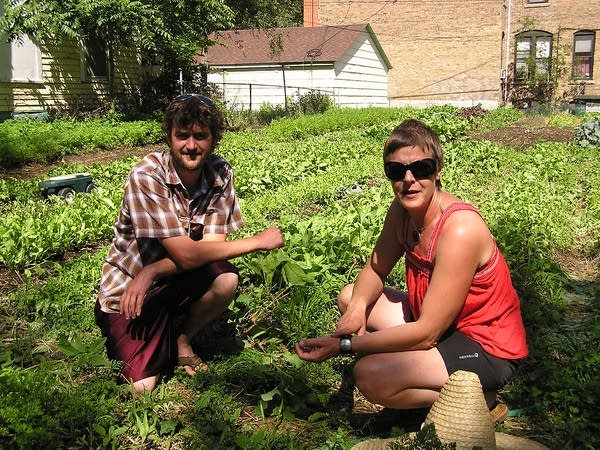Urban farming finding increased interest in Twin Cities

We're entering the peak season for Minnesota-grown fruits, vegetables and other produce, and a small but growing amount of the state's food is coming from urban farmers.
Urban farming is an old idea that is attracting new followers. Besides fruits and vegetables, urban farmers raise fowl and even fish. Urban farming advocates point to better taste and a smaller carbon footprint as benefits.
Karen Swanberg has an aquaponics setup on the front porch of her south Minneapolis home. It consists of a big fish tank filled with tilapia and a nearby bed of edible greens.
"Water is constantly being pumped into the grow bed, which in this case is made out of a 55-gallon drum cut in half lengthwise and then filled with gravel," described Swanberg.
Create a More Connected Minnesota
MPR News is your trusted resource for the news you need. With your support, MPR News brings accessible, courageous journalism and authentic conversation to everyone - free of paywalls and barriers. Your gift makes a difference.
The fish tank water carries the waste from the 22 tilapia and feeds the jungle-like collection of edible greens including watercress, bok choy and miner's lettuce in the gravel-filled grow bed. The clean water from the grow bed is then sucked back into the fish tank.

The fate of the tilapia?
"The plan is to eat them, soon," Swanberg said. "I actually have all the gear I need to kill them and eat them. We'll just see if I can do that."
Swanberg's tilapia are thriving, but she admits some of the greens could use more sun.
Sunshine is a challenge to urban farmers, at least in Minneapolis, a city blessed with a thriving urban forest which helps keep neighborhoods cool. The flip slide is shade can stunt some plant growth.
So when the chance to farm a sun-drenched vacant lot popped up, Julie Aponte jumped at the opportunity. Aponte said developers demolished the house on the lot and had plans to build condos just before the economy crashed.
"It didn't work out so, they were gracious enough to let us use the land," Aponte said.

Everyone's happy because instead of rubbish-strewn lot with a bumper crop of weeds, Aponte and her business partner John Seitz have turned the space into an urban garden fit for the cover of Fine Gardening Magazine.
Seitz and Aponte are business partners who own a company called Uptown Farmers.
When not at their day jobs at a food co-op, they are watering, weeding and harvesting on a couple of vacant lots and selling the produce at the Mill City Farmers Market.
Uptown Farmers relies on free, or nearly free, land agreements with vacant lot owners.
Seitz said it's less about the money than it is about showing others the amount of food that can be raised in the city.
"We're really trying to start a serious local food network of sorts," Seitz said. "This can work and this is a way entrepreneurs who are willing to work hard hopefully can make a living, or a half living anyways."
Urban farming has a long, if neglected and forgotten, history in the Twin Cities.
Long before we enjoyed lettuce from California and grapes from Chile, Twin Cities residents bought seasonal produce from local urban farming businesses called market gardens that ringed the Twin Cities. Most have long since been covered with suburban housing.
One of them, the Gibbs family farm, now the Gibbs farm museum in Falcon Heights, an inner-ring suburb, is a short walk from University of Minnesota agronomist Nick Jordan's office on the U's St. Paul campus.
One prediction is the world needs to double food production to keep up with population growth. Jordan sees the resurgence of interest in urban farming as a promising development.
"The question of where will more food come from is really the question of the day," Jordan said. "We are all going to be pressed to figure out how to grow significantly more food on this planet under really challenging circumstances."
Back on the porch of her south Minneapolis home, Karen Swanberg is 18 months into her exploration of aquaponics -- raising fish and plants.
"So right now, mostly different salad greens," Swanberg said. "But once you get into aquaponics that has full access to light, unlike the ones that I have right now, you can do anything. Tomatoes love it, cucumbers love [and] melons love it."
History shows that urban farming in Minnesota seems to flourish when crisis strikes; the crash of 1857, community gardens and victory gardens during the Great Depression and during World War II.
The economic crisis appears to be motivating a resurgence in urban farming. The question is: hen the economy recovers, will growers and consumers still be interested?
